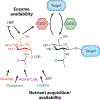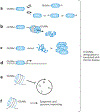O-GlcNAc cycling: a link between metabolism and chronic disease
- PMID: 23642195
- PMCID: PMC10483992
- DOI: 10.1146/annurev-nutr-071812-161240
O-GlcNAc cycling: a link between metabolism and chronic disease
Abstract
To maintain homeostasis under variable nutrient conditions, cells rapidly and robustly respond to fluctuations through adaptable signaling networks. Evidence suggests that the O-linked N-acetylglucosamine (O-GlcNAc) posttranslational modification of serine and threonine residues functions as a critical regulator of intracellular signaling cascades in response to nutrient changes. O-GlcNAc is a highly regulated, reversible modification poised to integrate metabolic signals and acts to influence many cellular processes, including cellular signaling, protein stability, and transcription. This review describes the role O-GlcNAc plays in governing both integrated cellular processes and the activity of individual proteins in response to nutrient levels. Moreover, we discuss the ways in which cellular changes in O-GlcNAc status may be linked to chronic diseases such as type 2 diabetes, neurodegeneration, and cancers, providing a unique window through which to identify and treat disease conditions.
Conflict of interest statement
DISCLOSURE STATEMENT
The authors are not aware of any affiliations, memberships, funding, or financial holdings that might be perceived as affecting the objectivity of this review.
Figures



References
-
- Albert SG, Oiknine RF, Parseghian S, Mooradian AD, Haas MJ, McPherson T. 2007. The effect of glucosamine on serum HDL cholesterol and apolipoprotein AI levels in people with diabetes. Diabetes Care 30:2800–3 - PubMed
-
- Anderson JW, Nicolosi RJ, Borzelleca JF. 2005. Glucosamine effects in humans: a review of effects on glucose metabolism, side effects, safety considerations and efficacy. Food Chem. Toxicol 43:187–201 - PubMed
-
- Andrali SS, Sampley ML, Vanderford NL, Özcan S. 2008. Glucose regulation of insulin gene expression in pancreatic β-cells. Biochem. J 415:1–10 - PubMed
-
- Biessels GJ, Staekenborg S, Brunner E, Brayne C, Scheltens P. 2006. Risk of dementia in diabetes mellitus: a systematic review. Lancet Neurol. 5:64–74 - PubMed
Publication types
MeSH terms
Substances
Grants and funding
LinkOut - more resources
Full Text Sources
Other Literature Sources

